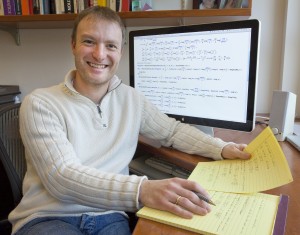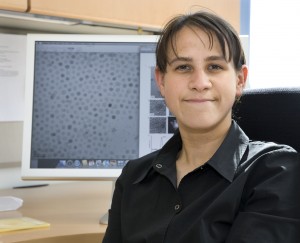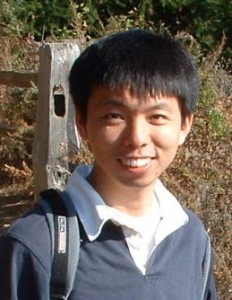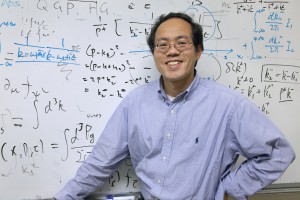Contact: Lynn Yarris (510) 486-5375, [email protected]
Investigations into the mysteries of the universe and matter at the most fundamental levels, and ground-breaking research into the application of nanomaterials to energy production, storage and conservation were recognized by the U.S. Department of Energy in announcing the first recipients of its Early Career Research Program. Four scientists with the Lawrence Berkeley National Laboratory (Berkeley Lab) – Christian Bauer, Delia Milliron, Feng Wang and Feng Yuan – were among the 69 recipients from across the nation who will divide up to $85 million in five-year research grants under the American Recovery and Reinvestment Act.
“This investment reflects the Obama Administration’s strong commitment to creating jobs and new industries through scientific innovation,” said Secretary of Energy Steven Chu who announced the winners. “Strong support of scientists in the early career years is crucial to renewing America’s scientific workforce and ensuring U.S. leadership in discovery and innovation for many years to come.”
Said Berkeley Lab director Paul Alivisatos, a strong proponent of this program, “I am delighted that DOE has recognized these four young Berkeley Lab scientists with Early Career Research awards. Each of their proposed projects had my full support for submission because each represents outstanding science that complements the strategic direction of this laboratory and supports the DOE Office of Science mission.”
Christian Bauer
 Bauer is a physicist with Berkeley Lab’s Physics Division whose project is titled, “GENEVA: An NLO event generator for the Large Hadron Collider.” His focus for the Early Career Research grant is on the complex particle collisions that will take place at CERN’s Large Hadron Collider (LHC), the world’s largest and highest energy particle collider. Drawing on the vast computational resources of the National Energy Research Scientific Computing Center (NERSC), which is located at Berkeley Lab, Bauer wants to develop a “full-fledged event generator” that will help experimenters discover and analyze new particles and forces at the LHC.
Bauer is a physicist with Berkeley Lab’s Physics Division whose project is titled, “GENEVA: An NLO event generator for the Large Hadron Collider.” His focus for the Early Career Research grant is on the complex particle collisions that will take place at CERN’s Large Hadron Collider (LHC), the world’s largest and highest energy particle collider. Drawing on the vast computational resources of the National Energy Research Scientific Computing Center (NERSC), which is located at Berkeley Lab, Bauer wants to develop a “full-fledged event generator” that will help experimenters discover and analyze new particles and forces at the LHC.
“Our ability to interpret the vast datasets from the LHC and to discover new physics at the energy frontier depends critically on reliable predictions of the experimental signatures derived directly from the interactions of the fundamental quanta of quantum chromodynamics,” Bauer says. “There are three main directions to improve on existing predictions: higher order perturbative calculations, improved logarithmic resummations, and improved models for the non-perturbative hadronic physics.”
While much has research has been invested into each of these three areas individually, Bauer says the three must be taken in combination for robust predictions. He will use his Early Career Research grant to provide a framework that allows for such a combination to be applied to results from hadron colliders such as the LHC.
Delia Milliron
 Milliron directs the Inorganic Nanostructures Facility for Berkeley Lab’s Molecular Foundry, one of the five DOE Nanoscale Science Research Centers. Her project is titled, “Inorganic nanocomposite electrodes for electrochemical energy storage and energy conservation.” The goal is to develop solution‐processed inorganic nanocomposite materials for efficient energy conversion, storage, and conservation devices, such as battery electrodes and electrochromic window coatings.
Milliron directs the Inorganic Nanostructures Facility for Berkeley Lab’s Molecular Foundry, one of the five DOE Nanoscale Science Research Centers. Her project is titled, “Inorganic nanocomposite electrodes for electrochemical energy storage and energy conservation.” The goal is to develop solution‐processed inorganic nanocomposite materials for efficient energy conversion, storage, and conservation devices, such as battery electrodes and electrochromic window coatings.
“Inorganic nanocomposites have recently emerged as a means of controlling the properties of electronic materials through morphology, as well as composition to give rise to combinations of properties not generally found in homogeneous, singlephase materials,” Milliron says. “I have recently demonstrated a new method for preparing inorganic nanocomposites from solution‐processible nanoparticle and molecular building blocks in a combinatorial manner.”
Milliron wants to apply this combinatorial chemistry approach to the fabrication of well‐controlled, chemically and morphologically tunable inorganic nanocomposites. The initial focus will be on the fabrication of nanocomposite battery electrodes whose optimized transport properties may resolve problems that now limit practical application of ultrahigh energy density conversion materials.
“If realized, the performance characteristics of these solution-processed inorganic nanocomposites could greatly expand the range of materials which can be considered for next generation electrochemical devices,” she says.
Feng Wang
 Wang holds joint appointments with Berkeley Lab’s Materials Sciences Division and the University of California, Berkeley Physics Department, where he leads the Ultrafast Nano-Optics group. His project is titled, “Control Graphene Electronic Structure for Energy Technology.” Graphene is a one-atom thick sheet of carbon that displays extraordinary electrical and mechanical properties, and is widely touted for its potential use in energy technologies. Wang’s goal is to understand and control this nanomaterial’s novel electrical, vibrational and optical behavior.
Wang holds joint appointments with Berkeley Lab’s Materials Sciences Division and the University of California, Berkeley Physics Department, where he leads the Ultrafast Nano-Optics group. His project is titled, “Control Graphene Electronic Structure for Energy Technology.” Graphene is a one-atom thick sheet of carbon that displays extraordinary electrical and mechanical properties, and is widely touted for its potential use in energy technologies. Wang’s goal is to understand and control this nanomaterial’s novel electrical, vibrational and optical behavior.
“Unlike what is seen in normal metals or semiconductors, electrons in graphene travel like the massless relativistic photons that make up light,” Wang says. “Graphene also exhibits incredible structural flexibility, mechanical strength, and unusual optical properties, but what is most remarkable is the possibility of being able to modify and control these properties through interlayer coupling, nanoscale patterning and electrical gating.”
Wang intends to apply advanced material nanofabrication, electronic characterization, and nanoscale optical spectroscopy to explore such possibilities as the development of a phonon laser for thermal energy research, the control of electron pseudospin for low power graphene nanoelectronics devices, and the use of electrical gating to control graphene as a transparent and variable work function electrode for fuel cells. In addition, he will also explore the use of graphene in solar cell devices to improve thin film solar cell performance.
Feng Yuan
 Yuan is a physicist with Berkeley Lab’s Nuclear Science Division. His project is titled, “Theoretical Investigation of Nucleon Structure.” The goal is to develop a theoretical framework and phenomenological techniques that could lead to a better understanding of nucleons – the collective name for the protons and neutrons that make up the nucleus of an atom.
Yuan is a physicist with Berkeley Lab’s Nuclear Science Division. His project is titled, “Theoretical Investigation of Nucleon Structure.” The goal is to develop a theoretical framework and phenomenological techniques that could lead to a better understanding of nucleons – the collective name for the protons and neutrons that make up the nucleus of an atom.
“Understanding the structure of the nucleon is a fundamental question in sub-atomic physics, and it has been under intensive investigation for the last several years,” Yuan says. “Modern research focuses in particular on the spin and the gluonic structure of the nucleon, which are key questions in current nuclear physics and major driving forces for research programs at the Relativistic Heavy Ion Collider and the Jefferson Lab.”
With his DOE Early Career Research grant, one of only three awarded for nuclear physics, Yuan will utilize Quantum Chromodynamics – the theory that describes how quarks and gluons interact to make nucleons and other hadron particles – to “unambiguously extract relevant non-perturbative nucleon structure from various experiments.”
He will focus on such issues as unveiling the difference and relevance in the proton spin sum rules, and building the connection to the light-cone wave function of a nucleon; improving the theoretical framework for describing transverse spin phenomena; and calculating various important effects of gluon saturation.
Berkeley Lab is a U.S. Department of Energy national laboratory located in Berkeley, California. It conducts unclassified scientific research for DOE’s Office of Science and is managed by the University of California. Visit our Website at www.lbl.gov/
Additional Information
For more information about the DOE Early Career Research grants, see the announcement at http://www.energy.gov/news2009/8525.htm
For more information about the research of Christian Bauer see http://www-theory.lbl.gov/~cwbauer/229B/Home.html
For more information about the research of Delia Milliron see http://foundry.lbl.gov/six/inorganic/staff-Delia_Milliron.html
For more information about the research of Feng Wang, see http://physics.berkeley.edu/research/fengwang/
For more information about the research of Feng Yuan, see http://www-nsdth.lbl.gov/